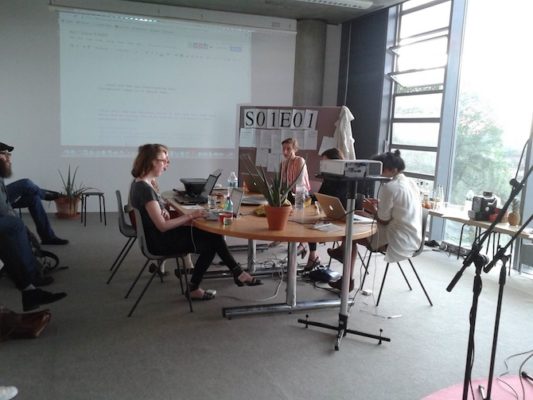Search
To search for an exact match, type the word or phrase you want in quotation marks.
A*DESK has been offering since 2002 contents about criticism and contemporary art. A*DESK has become consolidated thanks to all those who have believed in the project, all those who have followed us, debating, participating and collaborating. Many people have collaborated with A*DESK, and continue to do so. Their efforts, knowledge and belief in the project are what make it grow internationally. At A*DESK we have also generated work for over one hundred professionals in culture, from small collaborations with reviews and classes, to more prolonged and intense collaborations.
At A*DESK we believe in the need for free and universal access to culture and knowledge. We want to carry on being independent, remaining open to more ideas and opinions. If you believe in A*DESK, we need your backing to be able to continue. You can now participate in the project by supporting it. You can choose how much you want to contribute to the project.
You can decide how much you want to bring to the project.

If technological changes in cinematographic devices have historically changed the ways that film is made and understood, developments in the technology of the tools that affect the act of writing also ought to leave some kind of mark on the result. How has the digital era affected writing styles? Can the new technologies serve to expand the possibilities of language?
‘The Pool Exhibition’ opened last 4 July at London’s Goldsmiths University, showing the works of the students. Five floors and two pools, full of work, for five days. To avoid losing myself in the calculations of the University of Barcelona’s lack of any desire to achieve something of this magnitude, I’ll focus my attention on what happened on the floor occupied by the department of “Art Writing”, the work “4D Printer”. The artists Hannah Black, Kati Karki, Kyka Kordaski, Beatrice Loft Schulz and Mary Rinebold were sitting around a table, with a portable and an open, shared, Google Drive document. Also on the table: a printer and a projector that made it possible for the public to see what was going on in the document. In the same room, four actors waited.
According to the timetable the artist Daniel Rourke was the guest at this time. He gave the following instructions to the girls: you can only cut and paste; you can’t use control copy or delete; you may not write any new words, you can only ask for a word from each member of the public and these you can use as much as you like; you can recoup words from scripts written in other sessions. The girls had to follow these guidelines to edit the script of a scene from the series “My So Called Life”. After 20 minutes they printed a copy of the result for each of the actors, who read it out loud to those attending. As they finished, another invited artist, Maija Timonen entered, to give new instructions about the editing of the script for the following scene.
In this game of writing, by renewing what is already written, the “writers” totally abdicate any form of responsibility, as aside from writing with an appropriated text, they also ask a third person to command them how to do it. In this way, any new authority is left in the hands of this third person, the girls being liberated from their own voice, however much their personal ingenuity might affect the style of the end result.
What is interesting about Rourke’s task is that, on the one hand, he also makes the spectator responsible, as the word he or she gives will be repeated indefinitely throughout the text, like a wild card, revealing a new attitude in the script; and on the other, language finds itself reduced to the actions of cut and paste, in the end composing a clean and apparently simple collage of complex combinations.
I started by indicating that technologies would suppose essential changes in writing and “4D Printer” is an example. Here, the figure of the author disappears so that we find ourselves faced with editors of a text that can be eternally renewed, while leaving barely any trace of these changes. The editors find themselves immersed in a game of constant exchange of authorshi, concocting ephemeral results that will have no weight on the temporal line, as they are written, eliminated or transposed without there being time for them to be understood within the total coherence of the text. The simultaneous work of a collective on a unique specific support also surpasses the temporal dimension of the text as it is the limit that the group self-imposes upon itself that marks the end of the edition. In these games, the short cuts, that allow us to exercise control over the edition of a text, through the computer keyboard, are new linguistic elements that add endless possibilities. Finally, the interpretation is handed over to other subjects who, in reading it out loud to an audience, take on the role of being the one in charge of continuing its edition in other ways.
If Walter Benjamin in the age of mechanical reproduction already defined a point of brutal inflection in the forms of distribution and conceptual terms of the work of art, these aspects are still subject to changes in an era of many things, but amongst which are, virtual editing and interaction.

Anna Dot was born on a Sunday in April. She is from Torelló and works between two worlds, worlds that she cannot perceive as being in any way separate: one of artistic production and one of reflection, writing about contexts of art.
"A desk is a dangerous place from which to watch the world" (John Le Carré)